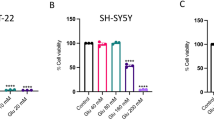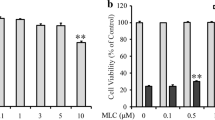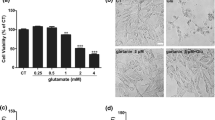Abstract
Oxidative stress is involved in many neurological diseases, including Alzheimer’s disease. Punicalagin (PC) is a hydrolysable polyphenol derived from Punica granatum and a potent antioxidant. In this study, the neuroprotective effect of PC on glutamate-induced oxidative stress was evaluated in the mouse hippocampal cell line, HT22. PC treatment protected HT22 cells from glutamate-induced cell death in a concentration-dependent manner, potentially attenuated glutamate-induced intracellular reactive oxygen species (ROS) and restored the mitochondrial membrane depolarization. Metabolic alterations after glutamate-induced oxidative stress and the protective effect of PC were evaluated with HPLC and GC-MS profiling methods with multivariate statistical analyses. Alterations in ten metabolites were identified, including amino acids, aspartic acid, asparagine, threonine, anserine, cysteine, tryptophan, lysine, as well as fatty acids palmitic acid, stearic acid, and palmitoleic acid. Metabolic pathway analysis revealed the involvement of multiple affected pathways, such as cysteine and methionine metabolism, tryptophan metabolism, alanine, aspartate, and glutamate and fatty acid oxidation. These results clearly demonstrate that PC is a promising therapeutic agent for oxidative stress-associated diseases.






Similar content being viewed by others
References
Berlett BS, Stadtman ER (1997) Protein oxidation in aging, disease, and oxidative stress. J Biol Chem 272:20313–20316
Bonda DJ, Wang X, Lee H-G, Smith MA, Perry G, Zhu X (2014) Neuronal failure in Alzheimer’s disease: a view through the oxidative stress looking-glass. Neurosci Bull 30:243–252
Brimson JM, Brimson SJ, Brimson CA, Rakkhitawatthana V, Tencomnao T (2012) Rhinacanthus nasutus extracts prevent glutamate and amyloid-beta neurotoxicity in HT-22 mouse hippocampal cells: possible active compounds include lupeol, stigmasterol and beta-sitosterol. Int J Mol Sci 13:5074–5097
Brosnan JT, Brosnan ME (2006) The sulfur-containing amino acids: an overview. J Nutr 136:1636S–1640S
Campesan S, Green EW, Breda C, Satyasaikumar KV, Muchowski PJ, Schwarcz R, Kyriacou CP, Giorgini F (2011) The kynurenine pathway modulates neurodegeneration in a drosophila model of Huntington’s disease. Curr Biol 21:961–966
Chen C, Pearson A, Gray JI (1992) Effects of synthetic antioxidants (BHA, BHT and PG) on the mutagenicity of IQ-like compounds. Food Chem 43:177–183
Chen PS, Li JH, Liu TY, Lin TC (2000) Folk medicine Terminalia catappa and its major tannin component, punicalagin, are effective against bleomycin-induced genotoxicity in Chinese hamster ovary cells. Cancer Lett 152:115–122
Choi DW (1988) Glutamate neurotoxicity and diseases of the nervous system. Neuron 1:623–634
Conklin SM, Runyan CA, Leonard S, Reddy RD, Muldoon MF, Yao JK (2010) Age-related changes of n-3 and n-6 polyunsaturated fatty acids in the anterior cingulate cortex of individuals with major depressive disorder prostaglandins. Leukot Essent Fatty Acids 82:111–119
Craig A, Cloarec O, Holmes E, Nicholson JK, Lindon JC (2006) Scaling and normalization effects in NMR spectroscopic metabonomic data sets. Anal Chem 78:2262–2267
Fierabracci V, Masiello P, Novelli M, Bergamini E (1991) Application of amino acid analysis by high-performance liquid chromatography with phenyl isothiocyanate derivatization to the rapid determination of free amino acids in biological samples. J Chromatogr 570:285–291
Folch J, Lees M, Stanley GHS (1957) A simple method for the isolation and purification of total lipides from animal tissues. J Biol Chem 226:497–509
Gliyazova NS, Huh EY, Ibeanu GC (2013) A novel phenoxy thiophene sulphonamide molecule protects against glutamate evoked oxidative injury in a neuronal cell model. BMC Neurosci 14:93
Gonzalez-Dominguez R, Garcia-Barrera T, Gomez-Ariza JL (2015a) Metabolite profiling for the identification of altered metabolic pathways in Alzheimer’s disease. J Pharm Biomed Anal 107:75–81
Gonzalez-Dominguez R, Garcia-Barrera T, Vitorica J, Gomez-Ariza JL (2015b) Deciphering metabolic abnormalities associated with Alzheimer’s disease in the APP/PS1 mouse model using integrated metabolomic approaches. Biochimie 110:119–128
Gostner JM, Becker K, Kurz K, Fuchs D (2015) Disturbed amino acid metabolism in HIV: association with neuropsychiatric symptoms. Front Psychiatry 6:97
Hardy J, Selkoe DJ (2002) The amyloid hypothesis of Alzheimer’s disease: progress and problems on the road to therapeutics. Science 297:353–356
Holmquist L, Stuchbury G, Berbaum K, Muscat S, Young S, Hager K, Engel J, Munch G (2007) Lipoic acid as a novel treatment for Alzheimer’s disease and related dementias. Pharmacol Ther 113:154–164
Kang Y, Tiziani S, Park G, Kaul M, Paternostro G (2014) Cellular protection using Flt3 and PI3Kα inhibitors demonstrates multiple mechanisms of oxidative glutamate toxicity. Nat Commun 5
Kincses ZT, Toldi J, Vecsei L (2010) Kynurenines, neurodegeneration and Alzheimer’s disease. J Cell Mol Med 14:2045–2054
Krishnaiah D, Sarbatly R, Bono A (2007) Phytochemical antioxidants for health and medicine-a move towards nature. Biotechnol Mol Biol Rev 1:97–104
Kritis AA, Stamoula EG, Paniskaki KA, Vavilis TD (2015) Researching glutamate - induced cytotoxicity in different cell lines: a comparative/, collective analysis/study. Front Cell Neurosci 9:2015
Krug AK, Gutbier S, Zhao L, Poltl D, Kullmann C, Ivanova V, Forster S, Jagtap S, Meiser J, Leparc G, Schildknecht S, Adam M, Hiller K, Farhan H, Brunner T, Hartung T, Sachinidis A, Leist M (2014) Transcriptional and metabolic adaptation of human neurons to the mitochondrial toxicant MPP (+). Cell Death Dis 5:e1222
Kulkarni AP, Mahal HS, Kapoor S, Aradhya SM (2007) In Vitro studies on the binding, antioxidant, and cytotoxic actions of punicalagin. J Agric Food Chem 55:1491–1500
Kumari S, Mehta SL, Li PA (2012) Glutamate induces mitochondrial dynamic imbalance and autophagy activation: preventive effects of selenium. PLoS One 7:e39382
Kuz’mina VV, Gavrovskaia LK, Ryzhova OV (2010) Taurine. Effect on exotrophia and metabolism in mammals and fish. Zh Evol Biokhim Fiziol 46:19–27
Lavanya G, Sivajyothi R, Manjunath M, Parthasarathy PR (2009) Fate of biomolecules during carbon tetrachloride induced oxidative stress and protective nature of Ammannia baccifera Linn.: a natural antioxidant. Int J Green Pharm 3:300–305
Lavanya G, Voravuthikunchai SP, Towatana NH (2012) Acetone extract from Rhodomyrtus tomentosa: a potent natural antioxidant. Evid Based Complement Alternat Med 2012:535479
Lee DS, Ko W, Kim DC, Kim YC, Jeong GS (2014) Cudarflavone B provides neuroprotection against glutamate-induced mouse hippocampal HT22 cell damage through the Nrf2 and PI3K/Akt signaling pathways. Molecules 19:10818–10831
Lin CC, Hsu YF, Lin TC, Hsu HY (2001) Antioxidant and hepatoprotective effects of punicalagin and punicalin on acetaminophen-induced liver damage in rats. Phytother Res 15:206–212
Lin CC, Hsu YF, Lin TC (1999) Effects of punicalagin and punicalin on carrageenan-induced inflammation in rats. Am J Chin Med 27:371–376
Louzada PR, Paula Lima AC, Mendonca-Silva DL, Noel F, De Mello FG, Ferreira ST (2004) Taurine prevents the neurotoxicity of beta-amyloid and glutamate receptor agonists: activation of GABA receptors and possible implications for Alzheimer’s disease and other neurological disorders. FASEB J 18:511–518
Majid S, Khanduja KL, Gandhi RK, Kapur S, Sharma RR (1991) Influence of ellagic acid on antioxidant defense system and lipid peroxidation in mice. Biochem Pharmacol 42:1441–1445
Mally J, Szalai G, Stone TW (1997) Changes in the concentration of amino acids in serum and cerebrospinal fluid of patients with Parkinson’s disease. J Neurol Sci 151:159–162
Manjunath M, Lavanya G, Sivajyothi R, Vijaya Sarathi Reddy O (2011) Antioxidant and radical scavenging activity of Actiniopteris radiata (Sw.) link. Asian Journal of Experimental Sciences 25:73–80
Manubolu M, Goodla L, Ravilla S, Thanasekaran J, Dutta P, Malmlof K, Obulum VR (2014) Protective effect of Actiniopteris radiata (Sw.) link. Against CCl (4) induced oxidative stress in albino rats. J Ethnopharmacol 153:744–752
Mariani E, Polidori MC, Cherubini A, Mecocci P (2005) Oxidative stress in brain aging, neurodegenerative and vascular diseases: an overview. J Chromatogr B 827:65–75
Markesbery WR (1997) Oxidative stress hypothesis in Alzheimer’s disease. Free Radic Biol Med 23:134–147
Martin V, Fabelo N, Santpere G, Puig B, Marin R, Ferrer I, Diaz M (2010) Lipid alterations in lipid rafts from Alzheimer’s disease human brain cortex. J Alzheimers Dis 19:489–502
Mattson MP (2000) Emerging neuroprotective strategies for Alzheimer’s disease: dietary restriction, telomerase activation, and stem cell therapy. Exp Gerontol 35:489–502
Mosmann T (1983) Rapid colorimetric assay for cellular growth and survival: application to proliferation and cytotoxicity assays. J Immunol Methods 65:55–63
Murphy TH, Miyamoto M, Sastre A, Schnaar RL, Coyle JT (1989) Glutamate toxicity in a neuronal cell line involves inhibition of cystine transport leading to oxidative stress. Neuron 2:1547–1558
Paglia G, Stocchero M, Cacciatore S, Lai S, Angel P, Alam MT, Keller M, Ralser M, Astarita G (2016) Unbiased metabolomic investigation of Alzheimer’s disease brain points to dysregulation of mitochondrial aspartate metabolism. J Proteome Res 15:608–618
Qin XY, Cao C, Cawley NX, Liu TT, Yuan J, Loh YP (2016 Apr.) Cheng Y (2016) decreased peripheral brain-derived neurotrophic factor levels in Alzheimer’s disease: a meta-analysis study (N = 7277). Mol Psychiatry 26
Redjems-Bennani N, Jeandel C, Lefebvre E, Blain H, Vidailhet M, Gueant JL (1998) Abnormal substrate levels that depend upon mitochondrial function in cerebrospinal fluid from Alzheimer patients. Gerontology 44:300–304
Reilmann R, Rolf LH, Lange HW (1995) Decreased plasma alanine and isoleucine in Huntington’s disease. Acta Neurol Scand 91:222–224
Ripps H, Shen W (2012) Review: taurine: a "very essential" amino acid. Mol Vis 18:2673–2686
Rosemberg DB, da Rocha RF, Rico EP, Zanotto-Filho A, Dias RD, Bogo MR, Bonan CD, Moreira JC, Klamt F, Souza DO (2010) Taurine prevents enhancement of acetylcholinesterase activity induced by acute ethanol exposure and decreases the level of markers of oxidative stress in zebrafish brain. Neuroscience 171:683–692
Seeram NP, Henning SM, Zhang Y, Suchard M, Li Z, Heber D (2006) Pomegranate juice ellagitannin metabolites are present in human plasma and some persist in urine for up to 48 hours. J Nutr 136:2481–2485
Shadrina MI, Slominsky PA, Limborska SA (2010) Molecular mechanisms of pathogenesis of Parkinson’s disease. Int Rev Cell Mol Biol 281:229–266
van der Goot AT, Zhu W, Vazquez-Manrique RP, Seinstra RI, Dettmer K, Michels H, Farina F, Krijnen J, Melki R, Buijsman RC, Ruiz Silva M, Thijssen KL, Kema IP, Neri C, Oefner PJ, Nollen EA (2012) Delaying aging and the aging-associated decline in protein homeostasis by inhibition of tryptophan degradation. Proc Natl Acad Sci U S A 109:14912–14917
Vauzour D, Vafeiadou K, Rodriguez-Mateos A, Rendeiro C, Spencer JPE (2008) The neuroprotective potential of flavonoids: a multiplicity of effects. Genes Nutr 3:115–126
Wang X, Wang W, Li L, Perry G, Lee HG, Zhu X (2014) Oxidative stress and mitochondrial dysfunction in Alzheimer’s disease. Biochim Biophys Acta 1842:1240–1247
Weon JB, Yang HJ, Lee B, Yun B-R, Ahn JH, Lee HY, Ma CJ (2011) Neuroprotective activity of the methanolic extract of Lonicera japonica in glutamate-injured primary rat cortical cells. Pharmacogn Mag 7:284–288
Xia J, Psychogios N, Young N, Wishart DS (2009) MetaboAnalyst: a web server for metabolomic data analysis and interpretation. Nucleic Acids Res 37:W652–W660
Xia J, Wishart DS (2010) MetPA: a web-based metabolomics tool for pathway analysis and visualization. Bioinformatics 26:2342–2344
Yi L, Shi S, Wang Y, Huang W, Xia ZA, Xing Z, Peng W, Wang Z (2016) Serum metabolic profiling reveals altered metabolic pathways in patients with post-traumatic cognitive impairments. Sci Rep 6:21320
Acknowledgements
This study was financially supported by Chulalongkorn University (RES560530255-AS). We are also thankful to the SAIF/CRNTS Department, IIT, Bombay (India) for providing the analytical facility. The author KP is thankful to Chulalongkorn University (Rachadapisek Sompot Fund) for providing a senior postdoctoral fellowship.
Author information
Authors and Affiliations
Corresponding author
Electronic supplementary material
Figure S1
HPLC chromatograms for amino acids (A) Standard (B) Control (C) Glutamate group (D) PC-GLU group (GIF 78 kb)
Figure S2
GC-MS chromatograms for Methanol fraction (A) Control (B) Glutamate group (C) PC-GLU group (GIF 92 kb)
Figure S3
GC-MS chromatograms for chloroform fraction (A) Control (B) Glutamate group (C) PC-GLU group (GIF 80 kb)
Rights and permissions
About this article
Cite this article
Pathakoti, K., Goodla, L., Manubolu, M. et al. Metabolic Alterations and the Protective Effect of Punicalagin Against Glutamate-Induced Oxidative Toxicity in HT22 Cells. Neurotox Res 31, 521–531 (2017). https://doi.org/10.1007/s12640-016-9697-2
Received:
Revised:
Accepted:
Published:
Issue Date:
DOI: https://doi.org/10.1007/s12640-016-9697-2




